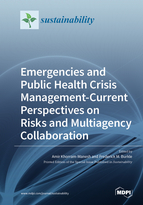Emergencies and Public Health Crisis Management- Current Perspectives on Risks and Multiagency Collaboration
A special issue of Sustainability (ISSN 2071-1050). This special issue belongs to the section "Health, Well-Being and Sustainability".
Deadline for manuscript submissions: 23 April 2024 | Viewed by 72911
Special Issue Editor
Interests: disaster and major incident; disaster management; emergency medicine; surgery
Special Issues, Collections and Topics in MDPI journals
Special Issue Information
Dear colleagues,
In most of the disaster events, regional and international assistance are available to affected areas and typically arrive days following the impact to help take up all needs and bridge the gap between the surge phase and the resumption of routine delivery. In some events (e.g., global pandemic), there are not the typical resources available to extend to neighboring regions. In such cases, building local response capabilities can greatly enhance community resiliency. The acute and postacute phase intrinsic response capability can be greatly enhanced through a regional and sustainable interagency emergency management system.
The successful management of emergencies and public health crises depends on the adequate measures implemented in all levels of the emergency chain of action, from policy makers to the general population. It starts with appropriate risk assessment, prevention, and mitigation, and continues to prehospital and hospital care, recovery, and evaluation. All levels of action require well-thought-out emergency management plans and routines based on established command and control, identified safety issues, functional communication, well-documented triage and treatment policies, and available logistics. All these characteristics are capabilities that should be developed and trained, particularly when diverse agencies are involved.
In addition to institutional responses, a robust, community-based disaster response system can effectively mitigate against and respond to all emergencies. A well-balanced response is largely dependent on local resources and regional responding agencies that all too often train and operate within “silos”, in the absence of interagency cooperation.
The importance of this Issue is its commitment to all parts of emergency and public health crisis management from a multiagency perspective. It aims to discuss lessons learned, introduce new ideas about flexible surge capacity, and show the way it can practice multiagency collaboration.
The main goal of this Issue is to bring together public health perspectives on the management of crises and develop the idea of multiagency management from a wider perspective.
Prof. Dr. Amir Khorram-Manesh
Collection Editor
Manuscript Submission Information
Manuscripts should be submitted online at www.mdpi.com by registering and logging in to this website. Once you are registered, click here to go to the submission form. Manuscripts can be submitted until the deadline. All submissions that pass pre-check are peer-reviewed. Accepted papers will be published continuously in the journal (as soon as accepted) and will be listed together on the special issue website. Research articles, review articles as well as short communications are invited. For planned papers, a title and short abstract (about 100 words) can be sent to the Editorial Office for announcement on this website.
Submitted manuscripts should not have been published previously, nor be under consideration for publication elsewhere (except conference proceedings papers). All manuscripts are thoroughly refereed through a single-blind peer-review process. A guide for authors and other relevant information for submission of manuscripts is available on the Instructions for Authors page. Sustainability is an international peer-reviewed open access semimonthly journal published by MDPI.
Please visit the Instructions for Authors page before submitting a manuscript. The Article Processing Charge (APC) for publication in this open access journal is 2400 CHF (Swiss Francs). Submitted papers should be well formatted and use good English. Authors may use MDPI's English editing service prior to publication or during author revisions.
Keywords
- public health
- emergencies
- disaster
- flexible surge capacity
- multiagency approach
- training
- exercises






